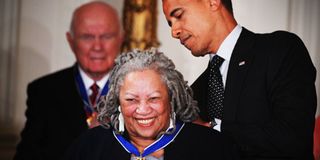Toni Morrison: here are her five standout writings

(FILES) In this file photo taken on May 29, 2012 US President Barack Obama presents the Presidential Medal of Freedom to author Toni Morrison during a ceremony in the East Room of the White House in Washington,DC. PHOTO|AFP
1. ‘The Bluest Eye’ (1970)
Morrison’s first novel, published when she was 39, focused on a young black girl in 1940s Ohio who dreams of having blue eyes -- synonymous in her mind with whiteness and beauty in a world shadowed by slavery.
It met with mixed response at the time of its release and sales were low, but its fortunes turned when it was added to a university reading list.
The novel has since provoked legal challenges and bans from schools in various US states for broaching controversial subjects.
2. ‘Song of Solomon’ (1977) -
Morrison’s second novel -- winner of the prestigious US National Book Critics Circle Award -- mixed magical realism, folklore and sociology to tell the story of a teenager trying to forget her past as a slave. It brought forth one of Morrison’s animating themes -- the troubled search for identity in a hostile world.
3. ‘Beloved’ (1987) -
With her fifth novel, Morrison created an overnight sensation by dramatising the harrowing true story of Margaret Garner, a fugitive slave who killed her daughter in 1856 to save her from a life of servitude.
“Beloved” controversially missed out on two top US awards when it was published, prompting 48 writers to sign an open letter in the New York Times Book Review decrying the failure to recognize Morrison.
It went on to win the Pulitzer Prize in 1988 and was adapted into a film 10 years later, starring Oprah Winfrey as the mother, Sethe.
4. ‘Paradise’ (1998) -
“Paradise” completed Morrison’s trilogy of novels, which began with “Beloved” and continued with “Jazz” (1992), challenging mainstream accounts of the past by exploring specifically African-American history from the mid-19th century to the present day.
5. ‘Home’ (2012) -
Opening the novel with the question “Whose house is this?”, Morrison goes on to explore another recurring theme in her work: the nature of home and how it makes or breaks us. (AFP)




